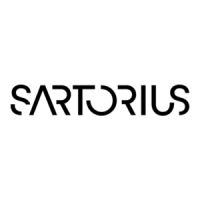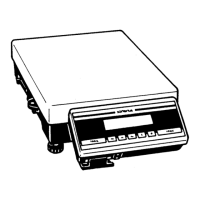Do you have a question about the Sartorius BP150 and is the answer not in the manual?
| Maximum Capacity | 150 g |
|---|---|
| Display | LCD |
| Readability | 0.1 mg |
| Repeatability | ± 0.1 mg |
| Linearity | ± 0.2 mg |
| Interface | RS232 |
Specifies allowable storage temperatures and handling precautions for safe transport.
Guidelines for selecting a suitable location, avoiding environmental factors that affect balance performance.
Connecting the balance to electronics, preparing the weighing chamber, and initial assembly steps.
Guidance on connecting the balance to AC power using the correct voltage adapter.
Covers safety precautions, voltage selection, and radio frequency interference guidelines.
Connecting external devices and advice on weighing electrostatically charged samples.
Step-by-step guide to leveling the balance using its integrated level indicator.
Procedures for balance warmup, turning the display on/off, and the self-test function.
Basic operations for taring the balance and determining sample weights.
Guide to performing internal calibration using the built-in calibration weight.
Instructions for external calibration and managing the access switch for verified balances.
Performing calibration tests, blocking functions, and using the interface port.
Procedures for below-balance weighing and fastening an antitheft locking device.
Guidelines for balance servicing, proper cleaning, and safety checks.
How to select specific functions by setting menu codes using the balance keys.
Detailed steps for accessing, navigating, and confirming menu code settings.
How to reset all menu code changes to factory settings using the reset function.
Adjusting balance settings for ambient conditions and selecting weighing modes.
Configuring tare parameters, auto zero function, and calibration/linearization functions.
Overview of available weight units and their conversion factors for selection.
Choosing display modes to balance accuracy requirements and readout speed.
Settings for baud rate, parity, stop bits, and handshake mode.
Setting data output parameters, auto print function, and output intervals.
Configuring automatic taring, application output, and using data ID codes.
Managing the menu access switch and blocking balance keys.
Connecting a remote control switch and configuring power-on modes.
Using the Tare Memory application program to store tare weights automatically.
Demonstrations of obtaining printouts for tare, net, gross, and net total weights.
Using the balance for compounding and weighing in percent.
Changing reference percentage and setting display parameters for percent readouts.
A practical example demonstrating the determination of residual weight in percent.
Setting and changing the reference sample quantity for piece counting.
A practical example illustrating the process of counting small parts.
Selecting manual or automatic start modes for averaging animal weights.
Configuring delayed start modes and the number of subweighing operations.
Setting storage threshold for automatic start and an example of animal weighing.
How to select and configure ISO/GLP compliant printout modes in the operating menu.
Format and details of printouts generated after adjustment, calibration, or linearization.
Steps and format for generating ISO/GLP compliant data records.
Including reference data and parameters in application program printouts.
Overview of connecting Sartorius balances to computers and peripherals via the interface port.
Explanations of special codes indicating balance status and operational errors.
Description of the data output format when including an ID code.
Structure and requirements for sending control commands to the balance.
Commands for controlling print, tare, calibration, keys, and ambient condition adaptation.
Commands for function keys, calibration tests, and outputting scale information.
Understanding data communication, parameters, and handshake settings.
Activating data output via print command or automatic processes.
Detailed technical specifications for the Sartorius Basicplus balances.
Information and order numbers for optional accessories like printers, displays, and battery packs.
Details on external calibration weights and data transfer/reader software.
Explanation of the CE mark and EU directives related to equipment compliance.











